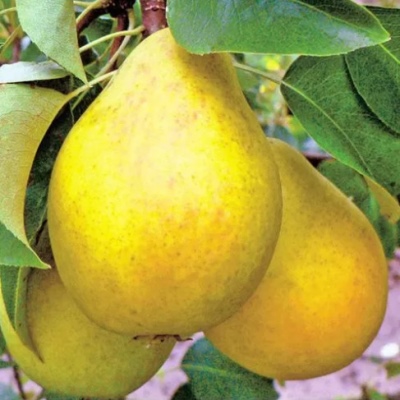
- Fruit weight, g: up to 400
- Ripening terms: winter
- Fruit picking time: in October
- Appointment: fresh
- Yield: medium
- Height, m: 80-140
- Crown: wide pyramidal
- Fruit color: lemon yellow or amber with a slight blush on the side
- Skin : smooth, dense
- Pulp : juicy, melting
The Duchess pear, known to everyone for its sweet fruits, is prone to attacks of parasites and is distinguished by a late onset of fruiting - mainly 5 years after planting. To avoid the use of insecticides and get a harvest already for 4 years, gardeners should pay attention to a variety called Duchess winter.
Breeding history
The winter variety Duchess was developed in Belgium.
Description of the variety
In winter, Duchesse reaches a height of 80-140 cm, has a wide-pyramidal crown. This variety differs from the summer version, as the name implies, in winter ripening periods. The purpose of the variety is fresh consumption.
Fruit characteristics
Fruits are large, reaching an average of 400 grams. The pulp is light shades, rather juicy, covered with a dense and smooth skin. Lemon-yellow pears, distinguished by the presence of a blush on the side.
Taste qualities
The fruits are sweet, but with a slight sourness, they smell good and melt in the mouth. Fruit tasting score - 4.8 points out of 5 possible.
Ripening and fruiting
The fruits should be harvested in October, and the maximum accumulation of nutrients is achieved in early December.
Early maturity occurs 4-5 years after planting.

Yield
The variety has an average yield: up to 100 kg can be obtained from one tree.
Growing regions
Pear Duchess Winter is suitable for growing in Russia, Ukraine and Belgium.
Self-fertility and the need for pollinators
The pear is characterized as self-fertile, therefore it requires the proximity of pollinating varieties. These include Williams, Olivier de Serre, Bere Ardanpon.
Landing
During the disembarkation process, you need to pay attention to:
- terms;
- choice of location;
- pit preparation rules;
- the need for fertilization and watering during planting.
Planting can be carried out in the spring (before the start of sap flow) or in the fall (after shedding the leaves). Each period has its own advantages and disadvantages. Winter saplings of the Duchess variety are recommended to be purchased in nurseries, they should look healthy, and the roots should not be dry.
For planting pears, it is recommended to choose sunny areas on a hill, closed from the wind. Pollinating varieties should be located nearby. A distance of at least 5 meters should be left between trees, up to 7 meters between adjacent rows.
It is recommended to prepare a pit for spring planting in the fall. The root system of the Duchess winter variety requires a pit 1.2 meters deep and up to 80 cm wide.A drainage is installed at the bottom, which is covered by 1/3 of soil mixed with fertilizers and peat. Fertile soil is watered with water, mulched with sawdust and left for at least 1.5 months. Before planting seedlings, the pit must be loosened and then watered thoroughly.


Growing and caring
Caring for the Duchess winter variety consists of the following stages:
- watering;
- fertilization;
- preparation for winter;
- pruning;
- protection against pests.
Watering pears is carried out once a week in the amount of 1-2 buckets per plant, in the future, the amount of water is increased, and the frequency is reduced.
The winter variety Duchess needs additional feeding, the schedule is as follows:
- nitrogen fertilizers are applied in the first 2-4 years when the leaves are blooming, in the future they are used only during nitrogen starvation;
- organic substances must be applied every 3 years;
- mineral dressings are applied annually;
- Nitrophoska and Kemira are often used, but wood ash and humus can be added instead.
The pear tree needs the following types of pruning:
- formative;
- sanitary support;
- anti-aging.



Disease and pest resistance
Duchess winter is affected by some diseases, which can be avoided through preventive measures. These include the timely removal of weeds, the correct application of top dressing and the processing of trees.
The pear of this variety is affected by the following diseases:
- scab;
- moniliosis;
- cytosporosis;
- powdery mildew;
- white spot.
The main pests include:
- green aphid;
- moth;
- leaf roll.

Like any other fruit trees, the pear needs protection from various diseases and pests. When planting a pear on your site, you need to know in advance what diseases you should beware of. To successfully carry out the struggle, it is necessary first to correctly identify the cause of the problem. It is important to distinguish signs of disease from manifestations of the presence of insects, mites, caterpillars and other types of pests.
Review overview
Gardeners speak positively about the Duchess winter pear. It is believed that the fruits resemble a summer variety, but, unlike it, are practically not affected by pests. Minimal care allows you to get a large harvest.





































































